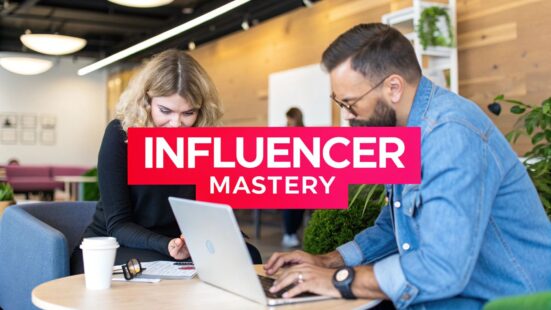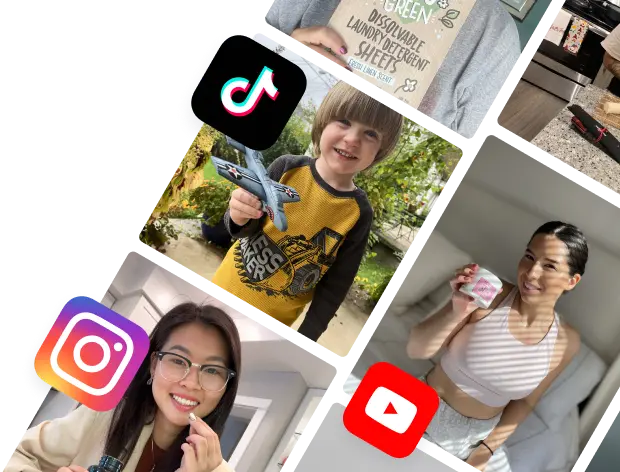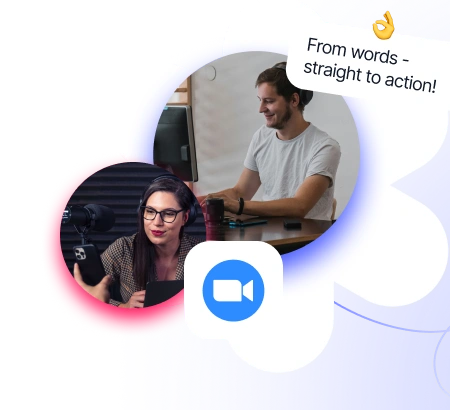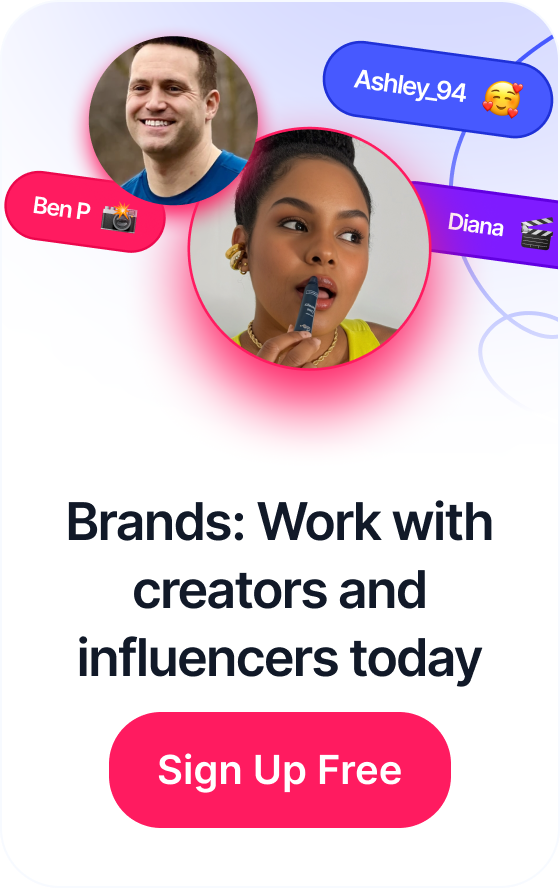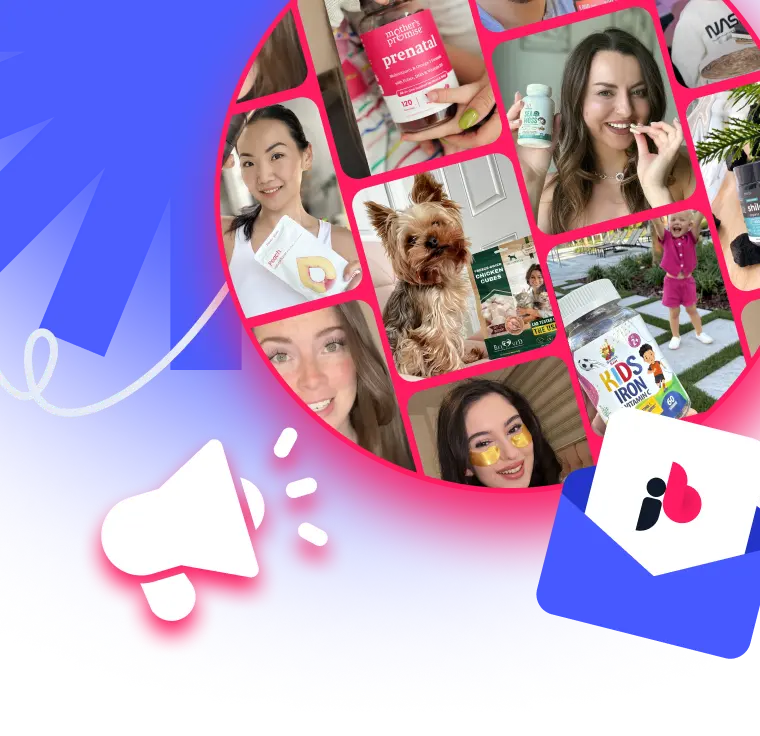 The Top 12 Best Free AI Video Maker Tools for Brands in 2025
The Top 12 Best Free AI Video Maker Tools for Brands in 2025
Before you even think about sliding into a DM or drafting an email, let's talk about what really makes an influencer partnership work. It’s not about finding the account with the most followers. The most successful campaigns I've ever been a part of were built on a solid foundation long before any creator was ever contacted.
Jumping straight into outreach without a plan is like setting sail without a map—you might generate some activity, but you'll have no idea if you're heading toward your actual destination. This upfront strategic work is what separates a flash-in-the-pan post that gets a few vanity likes from a meaningful partnership that delivers real business results.
And the stakes are higher than ever. The influencer marketing world is exploding, projected to become a $32.55 billion industry by 2025. That's a staggering jump from its $1.7 billion valuation back in 2016. You can see the full story in this influencer marketing benchmark report. To get your piece of that pie, you need a plan.
Define What Success Looks Like
First things first: What are you actually trying to accomplish? Your answer to this question will shape every other decision you make, from the type of creators you hire to the metrics you obsess over. You have to get more specific than just "creating buzz."
Think about what a win truly means for your brand. Are you trying to…
- Boost Brand Awareness? This is about getting your name in front of fresh, relevant eyes. You'll measure this with things like reach, impressions, and how often people are talking about your brand online.
- Drive Direct Sales? This is the most straightforward goal. You want people to see the post and immediately buy your product. Success here is all about tracking conversions through unique discount codes and affiliate links.
- Generate Qualified Leads? Maybe you're not selling a product directly, but collecting contacts for your sales pipeline. Think webinar signups, newsletter subscriptions, or downloads of a valuable resource.
- Build a Content Library? Sometimes the goal is to get a treasure trove of high-quality, authentic user-generated content (UGC) that you can then repurpose across your own ads, website, and social media.
A classic rookie mistake is trying to do everything at once with a single campaign. To get a clear picture of your ROI, focus on one primary goal and maybe one or two secondary ones. Keep it clean.
Set a Realistic and Comprehensive Budget
Your budget isn't just the number you agree to pay the influencer. I've seen too many campaigns get derailed by surprise costs that weren't factored in from the start. A truly comprehensive budget accounts for every single expense.
Don't forget to include line items for:
- Creator Compensation: This could be a flat fee, a commission on sales, or some kind of hybrid model. It's the most obvious cost, but it's just one piece of the puzzle.
- Product Costs: Remember to account for the retail value and the actual cost of goods for any products you're gifting.
- Shipping and Handling: Getting your product into the creator's hands costs money, and this can add up quickly, especially with international partners.
- Agency or Platform Fees: If you're working with an agency or using a tool like GRIN or CreatorIQ, their management or subscription fees need to be in the budget.
- Content Boosting: Want to get more mileage out of a great post? Set aside some ad spend to amplify the creator's content to an even wider audience.
Create Your Ideal Influencer Profile
Now you can start thinking about the person. And I mean the person, not just their follower count. Big numbers can be misleading; what you're really after is genuine connection and alignment. Think of this profile as your north star during the discovery phase—it will keep you focused on finding a true brand advocate.
To make sure your vision is crystal clear to everyone involved, it’s a great idea to learn how to write a creative brief. This document becomes your single source of truth for the campaign.
Your ideal influencer profile should detail:
- Audience Demographics: Does their audience actually match your target customer? Look at age, location, gender, and interests.
- Engagement Quality: Don't just look at the number of comments; read them. Are people having real conversations, or is it a wasteland of "Great post! 🔥" and spam bots?
- Brand Fit and Values: Does their overall vibe—their content style, tone of voice, and personal brand—feel like a natural extension of your own?
- Niche Relevance: Are they a credible, respected voice in your specific corner of the world? Authority matters.
Once you’ve defined your goals, budget, and ideal partner, you need to package it all into a clear, concise document. This is where the campaign brief comes in.
A well-structured brief is your best tool for preventing miscommunication and ensuring the creator knows exactly what's expected of them. It sets the stage for a smooth collaboration.
Key Elements of an Influencer Campaign Brief
| Component | Description | Example |
|---|---|---|
| Campaign Goal | The #1 thing you want to achieve with this partnership. | "Drive 500 sales of our new skincare serum using a unique 15% discount code." |
| Target Audience | A specific profile of the person you're trying to reach. | "Women aged 25-40 in the US who are interested in clean beauty and sustainable living." |
| Key Messaging | The core points you want the creator to communicate about your brand or product. | "Highlight the product's all-natural ingredients and eco-friendly packaging. Mention it's vegan and cruelty-free." |
| Deliverables & Timeline | Exactly what content is required and when it needs to be posted. | "One Instagram Reel and three Stories. Drafts for review by May 10th, post live by May 17th." |
| Content Guidelines | The 'do's and don'ts' to ensure brand safety and alignment. | "Do: Show the product in your morning routine. Don't: Mention any other skincare brands in the post." |
| FTC Disclosure | The required legal language for disclosing the paid partnership. | "Must include #ad or #sponsored clearly and conspicuously at the beginning of the caption." |
Having these components clearly laid out in your brief removes ambiguity and empowers the creator to produce their best work while staying perfectly on-brand.
Table of Contents
Finding and Vetting Authentic Creators

The single most important decision you'll make in any influencer campaign is who you choose to partner with. Get it right, and you’ll see incredible results. Get it wrong, and you're just throwing your budget and time down the drain. Forget endlessly scrolling through hashtags—that's a recipe for burnout. The key is to find a true brand advocate using smarter, more efficient discovery methods.
A fantastic place to start is right in your own backyard: your existing community. Who are your current superfans? These are the customers already buying your products and shouting you out on social media for free. Turning one of these organic fans into a paid partner is one of the most powerful and authentic moves you can make.
Another clever tactic? Look at what your competitors are doing. Who are they partnering with? Make a list of the creators they've worked with and take a close look at how those campaigns performed. This gives you a pre-vetted list of influencers who are not only familiar with your niche but also have an audience that's already interested in products just like yours.
Moving Beyond Manual Searches
While a bit of manual digging has its place, dedicated influencer marketing platforms can seriously speed things up. Tools like JoinBrands, Upfluence, or Aspire let you filter through enormous databases of creators using specific criteria, saving you countless hours of grunt work.
Typically, you can narrow your search by:
- Niche and Keywords: Zero in on creators who live and breathe topics like "sustainable fashion" or "vegan cooking."
- Audience Demographics: Target partners whose followers live in a specific city or fall into your ideal age range.
- Engagement Metrics: Filter for creators with a minimum engagement rate, which is a good sign of an active, healthy audience.
- Platform: Isolate creators who kill it on TikTok, YouTube, or whatever channel you’re focused on.
These platforms give you the hard data you need to build a strong list of potential partners fast. It's a far more reliable approach than just hoping to stumble across the right account.
The Art of Vetting for Authenticity
Once you've got a shortlist, the real work begins: vetting. This is where you have to look past the vanity metrics like follower count and dig into the real quality of a creator’s content and community. A high follower count can be bought, but genuine influence can't be faked.
Start by analyzing the quality of their engagement. Don't just glance at the number of likes and comments—actually read them. Are the comments genuine questions and thoughtful reactions from real people? Or is the feed clogged with generic, one-word replies and emojis from bots? The answer tells you everything you need to know about the health of their community.
Key Takeaway: I'll take a micro-influencer with 15,000 followers and a highly engaged, conversational comment section over a macro-influencer with 200,000 followers and a feed full of spam any day of the week.
It’s also crucial to understand how a creator has built their audience. Are they building a real community through valuable content? Knowing how to increase Instagram followers organically is a skill that separates the pros from those who rely on shady shortcuts.
Your Practical Vetting Checklist
To make sure you’re choosing a true partner, run every potential creator through this checklist. This simple process will help you spot red flags and confirm they're the right fit before you ever send that first outreach email.
1. Content and Brand Alignment
- Content Quality: Is their photography, video, and editing up to snuff? Does it look professional?
- Brand Voice: Does their tone—whether it's witty, educational, or inspiring—actually match your brand's personality?
- Previous Partnerships: Scan their past sponsored posts. Do they integrate products thoughtfully, or does their feed just look like a billboard for hire?
2. Audience Health and Authenticity
- Engagement Rate: Do the math: (Likes + Comments) / Followers x 100. A rate of 2-3% is generally considered good on Instagram, but this can vary a lot by niche and platform.
- Follower-to-Following Ratio: A creator who follows thousands more people than follow them can be a red flag for using aggressive (and ineffective) follow/unfollow tactics.
- Comment Quality: As I mentioned, look for real conversations. This is the clearest sign of a loyal community.
3. Professionalism and Vibe
- Profile Polish: Is their bio clear and professional? Do they provide an easy way to get in touch for business inquiries?
- Responsiveness: Check if they reply to comments and DMs from their audience. It's a great indicator that they actually care about the community they've built.
Going through these steps methodically ensures you're not just hiring a hired gun. You're building a partnership with someone who can authentically represent your brand to an audience that truly trusts them.
Crafting Outreach That Actually Gets a Response
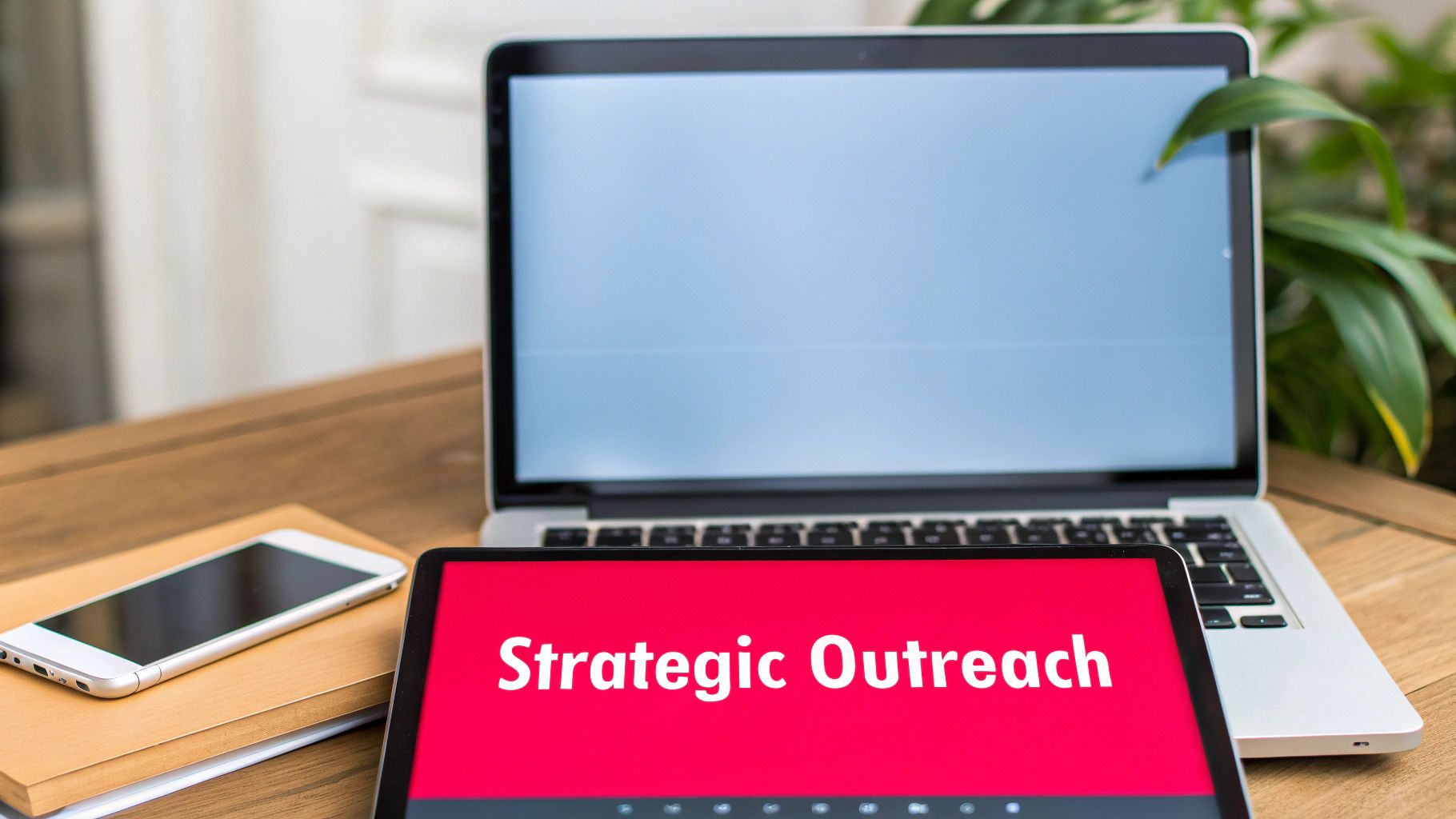
This is where the rubber meets the road. You’ve done the hard work of identifying creators who feel like a perfect fit. Now you have to actually reach out and get them on board.
Your first impression is everything. Let's be real: professional influencers get dozens, sometimes hundreds, of partnership requests every single day. Most are instantly deleted. Why? Because they’re lazy, generic, and scream "copy-paste."
Ditch the "Hey, love your content!" template right now. Your mission is to prove you're a serious brand that's actually paid attention to their work and sees a real, mutually beneficial partnership. Personalized outreach isn't just a nice extra—it's the only way to get a yes and start the relationship off right.
The Anatomy of a Perfect First Pitch
Think of your initial email as a masterclass in being concise yet compelling. You need to quickly show that you've done your homework and aren't just blasting a template to a list of a hundred random accounts.
A strong first pitch always nails these key elements:
- A Specific Compliment: Mention a specific recent post, video, or Story. Something like, "Your recent Reel breaking down that morning skincare routine was fantastic—the editing was so sharp and the tips were genuinely useful."
- A Clear "Why": Explain exactly why you think a partnership makes sense. This shows you're thinking strategically. Try this: "The way your audience trusts your recommendations for sustainable products feels like a perfect match for our new eco-friendly cleaning line."
- An Outline of the Ask: Briefly state what you have in mind. Don't send a five-page brief. Just give them the gist. For example, "We're looking for a partner to create one TikTok video to support our upcoming product launch in May."
- A Simple Call to Action: End with an easy next step. "Let me know if this sounds interesting, and I can send over more details" is perfect. It's low-pressure and respects their time.
This approach immediately separates you from the low-effort spam flooding their inbox.
Talking Money: Navigating Compensation and Negotiations
Once a creator shows interest, the conversation naturally shifts to the business side of things. This is where you'll hash out compensation, deliverables, and content rights. Handling this part of the conversation with professionalism is absolutely key to building a fair and lasting partnership.
Compensation isn't one-size-fits-all. The right model really depends on your campaign goals:
- Flat Fee: A fixed payment for a specific set of deliverables. This is the most common model and is great for brand awareness campaigns where tracking direct sales is tough.
- Commission/Affiliate: The influencer gets a cut of the sales they drive through their unique link or discount code. This is a performance-based model that works beautifully for direct-response campaigns.
- Hybrid Model: This is often the sweet spot—a combination of a lower flat fee plus a commission. It gives the creator guaranteed income for their work while also giving them a real incentive to drive sales.
Remember, you're paying for more than just a post. You're paying for the creator's time, their production skills, and the years of effort they've poured into building a trusted relationship with their audience.
Make it Official with a Rock-Solid Agreement
I’ll say this louder for the people in the back: never, ever work without a contract. I don't care if it's just a product-for-post trade. A formal agreement protects both you and the creator by making expectations crystal clear and preventing headaches down the road. It elevates a casual chat into a professional business deal.
This is especially critical when you realize that 61% of consumers globally trust influencer recommendations more than they trust traditional ads from brands. To maintain that trust, clarity is non-negotiable. You can dive deeper into this by reviewing international influencer marketing data that shows how authenticity drives consumer behavior.
Your agreement should clearly define:
- Detailed Deliverables: Be specific. One Instagram Reel and three Stories with two frames each. The more detail, the better.
- Content Usage Rights: Where can you use the content they create? On your website? In paid ads? For how long? Spell it out.
- Payment Terms: The exact compensation amount, how they’ll be paid, and on what schedule.
- Exclusivity Clauses: Is the creator blocked from working with your direct competitors for a certain period? Define that timeframe.
- FTC Disclosure Requirements: Mandate the use of
#ador#sponsoredto ensure everyone is complying with legal guidelines.
A clear, fair contract ensures everyone is on the same page before a single photo is taken, setting the stage for a smooth and successful campaign.
4. Kicking Off a Flawless Campaign Execution

Alright, the contracts are signed and you’ve found the perfect influencer. Now the real work begins. This is where the rubber meets the road—the operational phase that determines whether your campaign is a roaring success or a frustrating mess of back-and-forth emails.
Getting this part right is all about proactive management. It's not about micromanaging every little detail. Instead, it's about setting your creators up for success with clear direction and then trusting them to do what you hired them for: create amazing content.
The Creative Brief: Your Campaign’s North Star
Your creative brief is arguably the most critical document you'll create. It's the blueprint that aligns everyone's expectations and ensures the final content hits the mark without killing the creator's spark.
Think of it like this: you’re giving them a recipe. You provide the key ingredients (messaging points, product features) and a picture of the final dish (a TikTok driving sales), but you let the chef—the creator—work their magic in the kitchen.
A great brief provides guardrails, not a rigid script. Here’s what it absolutely needs:
- The Big Goal: Be crystal clear. Is it about driving traffic? Pushing downloads? Be specific. For example, "Drive qualified traffic to our new XYZ product page."
- Key Talking Points: Stick to just 2-3 must-have messages. These are your non-negotiables. Anything more, and it starts to sound like an ad read.
- Mandatory Elements: This is the simple stuff. List any handles to tag, specific hashtags to use, or the exact link-in-bio they need to feature.
- "Do's and Don'ts": This is your brand safety net. Be direct. "Do show the product in a real-life setting. Don't mention competitor products or use profanity."
This level of clarity empowers creators. It gives them the confidence to be creative within a framework that still meets your core business needs.
How to Handle Content Reviews Without Killing the Vibe
The content review stage is a classic friction point. I’ve seen so many brands get this wrong by trying to nitpick every word and edit the life out of the content. That’s the fastest way to strip away the authenticity you wanted in the first place.
It's easy to think influencers just get free stuff for a quick post. The reality is they're running a business. They spend hours researching, shooting, and editing—often on top of a 40-hour work week. Respect their craft and their time.
A good review process is a partnership, not a dictatorship.
- Set Clear Deadlines: Agree on a reasonable date for them to send over drafts for you to look at.
- Limit Feedback Rounds: Your contract should specify one, maybe two, rounds of revisions. This forces you to be thoughtful and consolidate your feedback, rather than sending a stream of endless small tweaks.
- Focus on What Matters: Your feedback should be about the big picture. Are there factual errors? Did they miss a mandatory hashtag? Is there a serious brand safety issue? It should not be about subjective things like their word choice or the music they picked.
This approach shows you respect their process and helps maintain the positive relationship you've worked to build.
Getting the Logistics and Communication Right
Beyond the creative side, smooth execution comes down to nailing the small, crucial details. This is where a lot of campaigns unfortunately stumble.
Shipping and Timelines
Getting the product into the creator's hands is step one. Don’t mess it up.
- Confirm the Address: Sounds obvious, but you’d be surprised. Double-check their shipping details before you send anything.
- Share the Tracking Info: Always provide a tracking number. It gives them peace of mind and is critical for campaigns with tight deadlines.
- Build in a Buffer: Factor shipping and delivery times into your overall campaign schedule. You don’t want a delay holding up the entire project.
Keeping the Lines of Communication Open
Consistent, positive communication is the glue that holds everything together. Pick one primary channel—whether it’s email or a dedicated platform like JoinBrands—and stick with it to avoid confusion.
You don't need to be overbearing. A simple weekly check-in can work wonders. A quick note like, "Hey! Just checking in to see if the package arrived and if you have any initial questions about the brief," goes a long way. This shows you’re organized and on top of things, and it helps you spot any potential problems early on.
Getting a Real Read on Your Campaign ROI
So, the content is live. The posts are up. But your job isn’t over—in fact, the most important part is just beginning. This is where you find out what actually worked, justify the spend, and start gathering intel for your next campaign. It’s time to move past the vanity metrics of likes and comments and get down to what really moves the needle for your business.
Real success isn't about making noise; it's about making an impact on your bottom line. That means getting granular with the key performance indicators (KPIs) you set way back in the planning stage. To pull this off, you need a solid tracking system.
Think of it like this: every step, from the initial brief to the final post, should be a domino in a chain. If they're all lined up correctly, measuring the final impact becomes much simpler.

When your workflow is tight like this, tracking and measuring isn't a headache; it's a natural final step.
Tracking Performance Like a Pro
Likes and views are nice for a quick ego boost, but they don’t keep the lights on. The real magic is in the data that shows you how an influencer's content actually changed their audience's behavior. This is where attribution becomes your most valuable player.
Here are the tried-and-true methods I rely on to get concrete results:
- UTM Parameters: These are little trackers you add to a URL. Give each influencer their own unique UTM link, and your analytics will show you exactly how many clicks, sign-ups, or sales came from their specific post. No more guessing.
- Unique Discount Codes: This is one of the cleanest ways to track direct sales. Assign a custom code, like "CHLOE20," to each creator. Every time that code is used at checkout, you have a direct, undeniable link between that influencer and a sale.
- Affiliate Links: A step up from basic UTMs, these links are built to track sales and often pay the creator a commission for every conversion they drive. This is powerful because it directly ties their earnings to their performance, motivating them to drive real results.
Using these tools lets you ditch the guesswork. You can confidently report, "This collaboration drove $5,000 in new revenue," instead of a vague, "Yeah, their post got a ton of engagement."
Crunching the Numbers: Your Influencer Marketing ROI
Once you have that hard data, calculating your return on investment is refreshingly straightforward. This simple formula will give you a clear, no-fluff picture of your campaign's financial performance.
ROI Formula: (Revenue Generated – Total Campaign Cost) / Total Campaign Cost x 100
Let's walk through a quick example. Say you spent a total of $2,000 on an influencer campaign—this includes their fee, any product costs, and shipping. By tracking their unique discount code, you see they brought in $6,000 in direct sales.
Here's how the math plays out:
- ($6,000 Revenue – $2,000 Cost) / $2,000 Cost = 2
- 2 x 100 = 200% ROI
That 200% ROI means for every single dollar you put into the campaign, you got two dollars back. These are the kinds of numbers that get budgets approved and prove that your influencer strategy is a genuine growth driver. To get this right, it's critical to use proven strategies to measure social media ROI and understand the full value exchange.
Don't Forget the Human Element
Numbers tell a huge part of the story, but they don't tell all of it. The best campaign wrap-ups I've ever done blend this quantitative data with qualitative insights—the stuff a spreadsheet can't capture.
Always pay close attention to these things:
- Audience Sentiment: What was the vibe in the comments section? Were people genuinely excited? Were they asking smart questions about the product? This is a goldmine for understanding brand perception.
- Content Quality: Did the creator knock it out of the park with stunning photos or videos? Great content is an asset you can repurpose for your own ads, website, or social feeds for months to come. That user-generated content (UGC) has a value all its own.
- Brand Mentions: Keep an eye on your brand's @mentions and overall social chatter during and after the campaign. A noticeable lift in organic conversation is a fantastic sign that you're building real brand awareness.
This holistic, data-informed approach completely changes how you view influencer marketing. It stops being about one-off creative hits and starts becoming a predictable, scalable, and incredibly effective marketing channel for your brand.
Frequently Asked Influencer Questions
Jumping into influencer marketing can feel like learning a new language, and it’s natural to have a lot of questions. Getting these partnerships right means understanding the business side of things, not just the creative aspect.
Remember, for many creators, this is their profession. They're not just posting a quick photo; they're running a small media business, complete with research, content planning, and hours of editing—often on top of a day job.
Let's tackle some of the most common questions we hear from brands.
How Much Should I Pay an Influencer?
This is the big one, and the honest answer is: it depends. There’s no universal rate card. An influencer's fee is a mix of their follower count, engagement rate, niche, and the specific content you’re asking for. A series of Instagram Stories is a very different beast than a professionally shot and edited YouTube video.
A good starting point many people use is the "1% rule": budgeting around $100 per 10,000 followers for a single in-feed Instagram post. But treat this as a ballpark figure, not a hard-and-fast rule. A creator with a hyper-engaged audience in a high-demand niche like finance or skincare can easily command more.
You'll usually see a few common payment models:
- Flat Fee: A straightforward payment for specific deliverables. This is perfect for brand awareness campaigns where you need guaranteed content.
- Commission (Affiliate): The creator gets a cut of the sales they generate through their unique link or code. It’s a great, performance-based option for driving direct revenue.
- Hybrid Model: This combines a smaller flat fee with a commission. It gives the creator some financial security while motivating them to drive sales—a win-win.
The best way forward? Just ask. Have an open conversation with the influencer or their manager about the scope of work and be ready to negotiate a price that fairly reflects their creative work and the value of their audience.
What Is the Difference Between Nano, Micro, and Macro Influencers?
The main difference here is audience size, but that single metric has a huge ripple effect on their reach, engagement, and how they connect with their followers. Each tier has a unique role to play in a well-rounded strategy.
- Nano-Influencers (1K–10K Followers): These creators have incredibly tight-knit communities. A recommendation from them feels less like an ad and more like advice from a trusted friend, which is why their engagement rates are often through the roof.
- Micro-Influencers (10K–100K Followers): This is the sweet spot for many brands. They have a great mix of solid reach and genuine community connection, often delivering the best overall ROI.
- Macro-Influencers (100K–1M Followers): These are the established pros. Think of them as the billboards of the influencer world, ideal for generating massive brand awareness quickly.
- Mega-Influencers (1M+ Followers): We’re talking celebrities and major public figures. They offer unparalleled exposure but come with the highest price tags and, typically, lower engagement rates relative to their size.
Your goals should guide your choice. For deep trust and authentic connection, go with nano and micro. For a big, splashy announcement, macro-influencers are your best bet.
It's telling that a recent report showed 44% of marketers now prioritize nano-influencers, with another 26% focusing on micro-influencers. The industry is clearly shifting toward valuing authentic engagement over just a big follower number.
Do I Need a Contract to Work With an Influencer?
Yes. Always. Without a doubt. A formal, written agreement is absolutely essential, even if you’re just gifting a product in exchange for a post. A contract is your safety net, protecting both you and the creator from misunderstandings.
Think of it as the official map for your partnership. It turns a friendly chat into a professional agreement where everyone is clear on their roles and responsibilities.
At a minimum, your contract must outline:
- Deliverables: Be specific. "One Instagram Reel and three Stories" is much better than "a post."
- Timelines: When are drafts due? When does the content go live?
- Compensation: The exact payment, how it will be paid, and on what schedule.
- Content Usage Rights: Spell out how and where you can reuse their content (e.g., on your website, in ads).
- FTC Disclosure Rules: A non-negotiable clause requiring the creator to use
#ador#sponsored.
Without a contract, you’re inviting potential headaches over payment, content ownership, or missed deadlines. It’s a simple step that makes the entire collaboration run more smoothly.
How Do I Find Influencers Who Fit My Brand?
Finding the right creator is less about matching keywords and more about finding a true partner whose values, aesthetic, and audience align with yours. The first step is to really know your customer. Who are they, what do they care about, and who do they already follow and trust?
Once you have that profile, you can start your search. You can do it manually by digging through hashtags on Instagram or TikTok or by checking out who your competitors are working with. This kind of digital sleuthing can give you a solid starting list.
For a faster, more data-backed approach, influencer marketing platforms are a game-changer. Tools like these let you filter huge databases of creators by niche, audience demographics, engagement rates, and even past brand collaborations. This not only saves a ton of time but also helps you uncover hidden gems you’d never find on your own.
After you've got a shortlist, do a deep dive. Look beyond the follower count. Read the comments, check out their other brand deals, and get a feel for their authentic voice. Is it a genuine match for your brand? That's the question you need to answer.
Ready to find and collaborate with the perfect creators for your brand? JoinBrands is an all-in-one platform connecting you with over 250,000 creators, including TikTok Shop affiliates and Instagram influencers. Streamline your entire workflow, from campaign creation and product shipping to content approval and ad activation, all in one place. Discover your next brand advocate on JoinBrands and start building partnerships that drive real growth.
